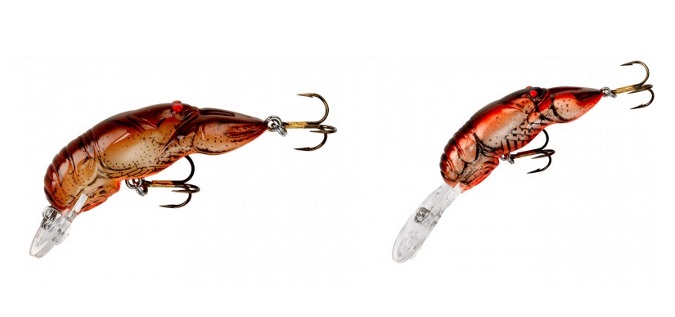“I got one,” my son called out excitedly from just downstream of where I was wading. I turned to him, expecting to see a fish flopping at the end of his line. Instead, he was kneeling in a shallow rocky run, with his rod set aside on a gravel bar, and he was proudly holding up a hand-caught crawdad.

I waded closer to admire his prize before he let it go and realized the craw he had caught was smaller and greener than the Rebel Crawfish I’d been using. He told me that he’d seen a few and that they’d looked similar.
We hadn’t had a bite yet (partly explaining why he was flipping rocks and chasing crawfish instead of casting for bass), so I was glad to experiment. I dug through my creek box and then replaced the Ditch Brown Wee-Crawfish (right) I had been using with a smaller and greener Moss Craw Deep Teeny Wee (left).
I can’t ever prove that changing lures to match the forage was the key that day, but you sure won’t ever convince me otherwise. After an hour or so of no action, I immediately began catching smallmouth bass and rock bass, and when my son rigged up with a matching craw he started catching fish as well.
The perfect forage match isn’t always the best size or color of lure. Sometimes fish react better to a bright attractor color like Fire Tiger, and at times conditions dictate a certain type of color or a larger lure for visibility or reaching the fish. Still other times, the fish are just moody. Often, however, the most accurate match indeed works best, and it never hurts to know exactly what the fish are eating.
That day in the stream a couple of years ago reminded me of the value of searching out forage clues, and it’s something I really try to incorporate into my fishing.
Sometimes that means flipping a few rocks or sifting through vegetation to see if there are crawfish or hellgrammites nearby, and, if so, what they look like in that particular waterway. Often, it simply means peering into the water through polarized glassed in different areas to see the shape, size and color of any forage fish. Other times, the clues are found in the grass or on logs on the bank in the form of grasshoppers, crickets and frogs.
Rebel makes many lures that offer highly accurate matches for popular forage fish and critters. Paying careful attention to what’s around you can help the make best lure selections and consequently catch more fish.
J. Samsel
